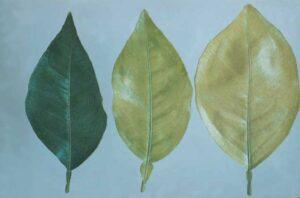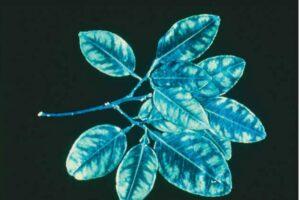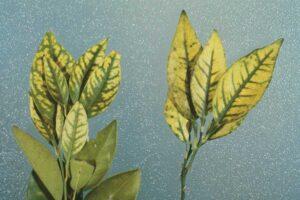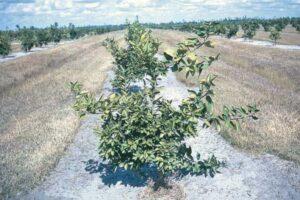Nitrogen

Deficiency is expressed by light green to yellow foliage over the entire tree in the absence of any distinctive leaf patterns. With mild deficiency, foliage will be light green progressing to yellow as conditions intensify. New growth usually emerges pale green in color but darkens as foliage expands and hardens. With yellow vein chlorosis, the midribs and lateral veins turn yellow while the rest of the leaf remains a normal green color. Nitrogen deficiency will limit tree growth and fruit production, while high nitrogen applications produce excessive vegetative growth at the expense of fruit production, reducing fruit quality and threatening groundwater, particularly on vulnerable soil types.
Magnesium

The first symptom is a yellowish green blotch near the base of the leaf between the midrib and the outer edge. The yellow area enlarges until the only green remaining is at the tip and base of the leaf as an inverted V-shaped area on the midrib. With acute deficiency, leaves may become entirely yellow-bronze and eventually drop. Dolomite will correct mild foliage symptoms in soils with low to neutral pH. Magnesium deficiency occurring in calcareous soil may have to be corrected with foliar applications.
Manganese

Deficiency appears as dark green bands along the midrib and main veins surrounded by light green interveinal areas giving a mottled appearance. As severity increases, the light green interveinal areas give way to a yellow-bronze coloration. Both manganese and zinc deficiencies may occur on calcareous soil and may be more severe on trees with highly pH-sensitive rootstocks.
Zinc

Early stages appear as small blotches of yellow between green veins on the leaf. With severe deficiency, leaves may become increasingly yellow except for the green veinal areas. Under severe deficiency conditions, leaves will also be small with narrow pointed tips on terminal growth. Foliar fertilizer applications are usually recommended for correcting zinc deficiency. Trees with citrus blight will also show leaf symptoms of zinc deficiency.
Iron

In mild cases, leaf veins are slightly darker green than interveinal areas with symptoms appearing first on new foliage. In severe cases, interveinal areas become increasingly yellow with entire area eventually becoming ivory in color with emerging foliage, which is smaller. Trees may become partially defoliated with eventual twig and canopy dieback. Iron deficiency is usually an indication of calcareous soil condition and is more likely to be expressed on high pH-sensitive rootstocks like Swingle citrumelo. An early expression of flooding damage to roots and of copper toxicity may be iron deficiency symptoms.
Copper

Mild copper deficiency is usually associated with large, dark green leaves on long soft angular shoots. Young shoots may develop into branches which appear curved or “S-shaped,” referred to as “ammoniation” usually resulting from excessive nitrogen fertilization. Twigs can develop blister-like pockets of clear gum at node. As twigs mature, reddish brown eruptions may occur in the outer portion of the wood. Severely affected twigs commonly die back from the tip with new growth appearing as multiple buds or “witches’ broom”. Necrotic-corky areas on the fruit surface may sometimes occur in extreme situations. Copper deficiency is more likely to occur in new plantings on previously uncropped soils, which are usually deficient or totally lacking in copper.
Molybdenum

Rarely observed, it can occur under acidic soil conditions. The most characteristic field symptoms are large yellow spots on the leaves that appear first as less defined water-soaked areas in spring, later developing into distinct larger interveinal yellow spots.
Salt injury

While not a nutrient deficiency, this is something we see here on island.
Many salinity-induced symptoms are similar to drought stress symptoms, including reduced root growth, decreased flowering, smaller leaf size, and impaired shoot growth. These can occur prior to more easily observed ion toxicity symptoms on foliage. Chloride toxicity, consisting of burned necrotic or dry appearing edges of leaves, is one of the most common visible salt injury symptoms. Actual sodium toxicity symptoms can seldom be identified but may be associated with the overall leaf “bronzing” and leaf drop characteristic of salt injury. Slightly different symptomology may occur depending on whether injury is due to root uptake or foliage contact. Excessive fertilizer applications, highly saline irrigation water, and storm-driven ocean sprays can all result in salinity-induced phytotoxic symptoms.
*All text and photographs are from
Futch, Steven and Tucker, David. 3/18/21. A Guide to Citrus Nutritional Deficiency and Toxicity Identification. UF, IFAS Extension. Accessed 9/23.
https://edis.ifas.ufl.edu/publication/CH142
TMF/JS-9-28-23



